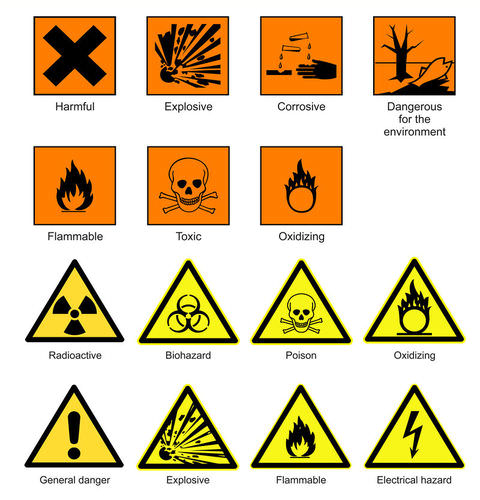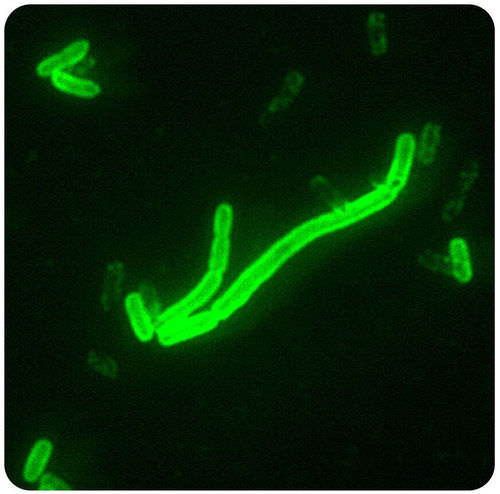1.7生命科学中的安全
章节大纲
-
What does this sign mean?
::这个标志是什么意思?If a substance is corrosive, it can eat through objects. Many scientists have to work with chemicals that are corrosive or otherwise dangerous. That's one reason that following safety precautions in the laboratory or field is very important.
::如果一种物质具有腐蚀性,它可以通过物体食用。许多科学家不得不使用具有腐蚀性或其他危险性的化学品。这就是在实验室或田间采取安全防范措施非常重要的原因之一。Safety in the Life Sciences
::生命科学安全There can be some very serious safety risks in scientific research. If researchers are not careful, they could poison themselves or contract a deadly illness. The kinds of risks that scientists face depend on the kind of research they perform. For example, a scientist working with bacteria in a laboratory faces different risks than a scientist studying the behavior of lions in Africa, but both scientists must still follow safety guidelines. Safety practices must be followed when working with the hazardous things such as parasites , radiation and radioactive materials, toxins, and wild animals . Also, carcinogens , which are chemical that cause , , which are disease-causing , bacteria or , and teratogens , which are chemical that cause deformities in developing embryos , are extremely hazardous, and extreme care must be used when working with these items as well. For example, scientists studying dangerous organisms such as Yersinia pestis , the cause of bubonic plague, use special equipment that helps keep the organism from escaping the lab.
::科学研究中可能存在一些非常严重的安全风险。 如果研究人员不小心, 他们可能会毒害自己或感染致命疾病。 科学家所面临的风险取决于他们所从事的研究种类。 例如, 实验室中与细菌打交道的科学家所面临的风险与研究非洲狮子行为的科学家不同, 但两位科学家仍必须遵循安全准则。 在研究寄生虫、辐射和放射性材料、毒素和野生动物等危险物品时, 必须遵守安全做法。 另外, 致癌物, 即导致疾病、细菌或致病的化学物质, 以及致畸的致畸体胚胎的化学物质, 极为危险, 而且在研究这些物品时必须极其谨慎。 例如, 研究危险生物的科学家, 如害虫, 虫病害, 使用特殊设备帮助生物体远离实验室。A biohazard is any biological material that could make someone sick, including disease-causing organisms. Therefore, a used needle is a biohazard because it could harbor contaminated with a disease-causing organism. Bacteria grown in a laboratory are also biohazards if they could potentially cause disease.
::生物危害是指可能使人生病的任何生物材料,包括疾病致病生物。 因此,旧针是一种生物危害,因为它可能窝藏着受疾病致病有机体污染的细菌。 实验室培育的细菌如果可能引发疾病,也是一种生物危害。Science laboratory safety and chemical hazard signs. Laboratory Safety
::实验室安全If you perform an experiment in your classroom, your teacher will explain how to be safe. Professional scientists follow safety rules as well, especially for the study of dangerous organisms like the bacteria that cause bubonic plague ( Figure ).
::如果你在课堂上做实验,你的老师会解释如何安全。专业科学家也会遵守安全规则,特别是研究细菌等危险生物,这些细菌会引发鼠疫(图 ) 。Sharp objects, chemicals, heat, and electricity are all used at times in laboratories. Below is a list of safety guidelines that you should follow when in the laboratory:
::尖锐物体、化学品、热能和电力有时都用于实验室。以下是实验室中应遵循的安全准则清单:- Be sure to obey all safety guidelines given in lab instructions and by your teacher.
::务必遵守实验室指令和老师 给出的所有安全准则
- Follow directions carefully.
::谨慎地遵循方向。
- Tie back long hair.
::背部长发。
- Wear closed toe shoes with flat heels and shirts with no hanging sleeves, hoods, or drawstrings.
::穿紧身脚鞋,穿平鞋和衬衫,没有吊袖、头罩或纹身。
- Use gloves, goggles, or safety aprons when instructed to do so.
::奉命使用手套、护目镜或安全围裙。
- Broken glass should only be cleaned up with a dust pan and broom. Never touch broken glass with your bare hands.
::碎玻璃只能用扫帚和扫帚来洗干净,不得赤手空拳地碰碎玻璃。
- Never eat or drink anything in the science lab. Table tops and counters could have dangerous substances on them.
::科学实验室里从不吃或喝任何东西 桌子顶和柜台上都有危险物质
- Be sure to completely clean materials like test tubes and beakers. Leftover substances could interact with other substances in future experiments.
::其余物质在今后的实验中可与其他物质发生相互作用。
- If you are using flames or heat plates, be careful when you reach. Be sure your arms and hair are kept far away from heat.
::如果使用火焰或热板,请在到达时小心。请务必保持手臂和头发远离热量。
- Alert your teacher immediately if anything out of the ordinary occurs. An accident report may be required if someone is hurt. Also, the teacher must know if any materials are damaged or discarded.
::如果发生任何异常情况,请立即通知教师。如果有人受伤,可能需要提供事故报告。此外,教师必须知道任何材料是否受损或被丢弃。
Scientists studying dangerous organisms such as Yersinia pestis, the cause of bubonic plague, use special equipment that helps keep the organism from escaping the lab. Field Research Safety
::外勤研究安全A field scientist studies abiotic and biotic factors in a natural setting, which is not usually an indoor laboratory. Scientists who work outdoors are also required to follow safety regulations. These safety regulations are designed to prevent harm to themselves, other humans, animals, and the environment. If scientists work outside the country, they are required to learn about and follow the laws and restrictions of the country in which they are doing research. For example, entomologists following monarch butterfly ( Figure ) migrations between the United States and Mexico must follow regulations in both countries. Before biologists can study protected wildlife or plant species , they must apply for permission to do so, usually from the government. This is important to protect these fragile species. For example, if scientists collect rare butterflies, they must first get a permit. They must also be careful to not disturb the habitat .
::野外科学家研究自然环境中的非生物和生物因素,而自然环境通常不是室内实验室。户外工作的科学家也需要遵守安全条例。这些安全条例旨在预防伤害自己、其他人类、动物和环境。如果科学家在国外工作,他们必须学习和遵守研究所在国的法律和限制。例如,在美国和墨西哥之间跟随君主蝴蝶(Figure)迁移的昆虫学家必须遵循两国的规章。生物学家在研究受保护的野生生物或植物物种之前,必须申请许可,通常是从政府申请。这对于保护这些脆弱物种很重要。例如,如果科学家收集稀有的蝴蝶,他们必须首先获得许可。他们还必须小心不要扰乱生境。A monarch butterfly. Summary
::摘要- There are serious risks in scientific research, including carcinogens, biohazards, and toxins.
::科学研究存在严重风险,包括致癌物、生物危害和毒素。
- You need to carefully follow all safety rules while working in the laboratory.
::您在实验室工作时需要谨慎遵守所有安全规则。
Explore More
::探索更多Use the resources below to answer the questions that follow.
::利用以下资源回答以下问题。Explore More I
::探索更多- FSU Chemistry Lab Safety at (6:51)
::FSU 化学实验室安全(6:51)
- Is applying cosmetics in a lab allowed?
::允许在实验室里施用化妆品吗?
- What should you do if there is an accident?
::如果出了意外怎么办?
- How should you dispose of waste?
::你该如何处置废物?
Explore More II
::探索更多情况二- Science Lab Safety Rules at (2:24)
::《科学实验室安全规则》第(2:24)条
- List five lab safety rules covered in the video.
::列出录影带中包含的五条实验室安全规则
- What kind of clothing should you wear in a science lab?
::你在科学实验室应该穿什么样的衣服?
- What should you wear in a science lab that you would not usually wear outside of a science lab?
::你通常不会在科学实验室外穿的 科学实验室里穿什么?
Review
::回顾- What is a biohazard?
::什么是生物危害?
- List three hazards found in scientific research.
::列出科学研究中发现的三种危险。
- List three safety guidelines that you should follow in the laboratory.
::列出实验室应遵循的三条安全准则。
- Be sure to obey all safety guidelines given in lab instructions and by your teacher.



